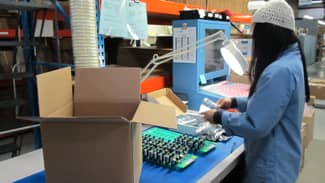As you’ve learned in Part 1 and Part 2 of this series, much of the actual work in getting your custom electronics job processed is completed well before it ever goes into production. In this final part of the series, we’ll walk through what to expect during the first production run and the follow up process, and how the relationship is maintained after the receipt of the first order.
What To Expect From the First Custom Electronics Production Run
The master scheduler slots the job into the shop’s schedule where it fits appropriately. The customer is immediately updated on the rare occasion that the order cannot meet the promised shipment date.
Then the job goes into production. A member of the Quality Engineering team witnesses the first run to ensure that it runs smoothly, works through any issues that arise, and documents any future adjustments needed to address quality. During this phase of the process, the assembly and test procedures are also written.
 Once the job is complete, it moves into testing and then on to shipping to be prepared for delivery. If there is any leftover inventory, it is handled however the original proposal had outlined.
Once the job is complete, it moves into testing and then on to shipping to be prepared for delivery. If there is any leftover inventory, it is handled however the original proposal had outlined.
Getting Feedback Is Vital to Making Process Improvements
Once the job has shipped, it is crucial to take any lessons learned and capture them while they’re fresh so they may be applied on the next run of that product. This takes shape in a couple of different ways:
- Internally, a quality control specialist hosts a full internal review. All departments that participated on the job are involved in order to capture the lessons learned.
- The assembly and test procedures created during the production phase are also finalized and confirmed so the next order that comes through can move through the shop more efficiently.
- Most importantly: on the customer side, an online survey is conducted twice a year to all customers to gather performance feedback. This is the most critical feedback we can get – and our business depends on it.
An Ongoing Relationship for Your Recurring Small Batch Custom Electronics Orders
A customer-centric team brings together a Customer Liaison, an Engineer, and a Materials Buyer and organizes them into a cohesive unit that functions as single unit to serve the customer’s needs. This helps individual orders flow smoothly through this shop process, and provides a stable team of contacts who are familiar with each customer’s particular needs and requirements. So from job to job, or assembly to assembly, the customer-centric team can transfer knowledge gained from working with the customer on past jobs, helping all aspects of the relationship to flow more smoothly and efficiently. This allows the relationship to add more value all around.
Some additional benefits to the customer of having these customer-centric teams in place include:
- Faster quote turnaround on future custom electronics assemblies
- Overall increased reliability on the level of work provided by the job shop due to the involvement and familiarity the customer-centric teams have with the customer and product
- Complete continuity and understanding of customer product lines
For RBB, our process is in support of our overall mission: “We exist to move heaven and earth to get our recurring small batch customers what they want, when they want it.”
If you missed either Part 1 or Part 2 of this series on the process of how your order flows through a custom electronics job shop, check them out. And if you have feedback on how this process could be improved, we’re all ears. Leave us a comment.






